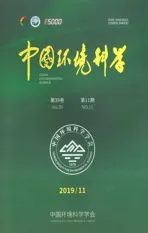珠三角河流饮用水源中皮质激素的污染与风险
2019-11-27林粲源熊小萍周永顺吴翠琴
林粲源,龚 剑*,熊小萍,周永顺,吴翠琴
珠三角河流饮用水源中皮质激素的污染与风险
林粲源1,2,龚 剑1,2*,熊小萍1,2,周永顺1,2,吴翠琴1,2
(1.广州大学环境科学和工程学院,广东省放射性核素污染控制与资源化重点实验室,广东 广州 510006;2.广州大学珠江三角洲水质安全与保护教育部重点实验室,广东 广州 510006)
利用固相萃取联合液相色谱-质谱法对珠三角河流饮用水源中的21种糖皮质激素(GCs)和3种盐皮质激素(MCs)进行了研究.结果发现,24种目标物在水源水中均有检出,检出率在8%(可的松)~75%(地夫可特)之间,总浓度(∑CSs)(平均值/中值)为0.29~8.7ng/L(2.6ng/L/1.6ng/L),污染以布地奈德、丙酸氯倍他索、醛固酮为主.东江东莞段和流溪河下游水源水中肾上腺皮质激素(CSs)浓度水平总体高于西江和北江,各水源地的CSs组成与浓度存在一定的季节性差异.冗余分析发现,水源水中大部分CSs与水温、电导率、pH值以及溶解氧呈负相关关系,表明这些环境因子是影响CSs含量分布的重要因素.CSs在珠三角河流水源地的危害指数(HI)(平均值/中值)在<0.1~0.65(0.25/0.29)之间,总体处于中低风险水平.
皮质激素;饮用水源;内分泌干扰物;珠江三角洲
环境内分泌干扰物(EEDCs),是一种外源性干扰内分泌系统的化学物质,通过摄入、积累等各种途径,通过干扰生物或人体内保持自身平衡和调解发育过程天然激素的合成、分泌、运输、结合、反应和代谢等过程对生物体或人类的生殖、神经和免疫系统等功能产生影响[1-3].
近几十年,关于水环境中典型内分泌干扰物研究主要集中在类固醇性激素和烷基酚类上[4-5],而同样参与人体重要代谢功能的另一类类固醇:肾上腺皮质激素(CSs)的相关研究相对较少[6-8].这类类固醇激素主要产生于脊椎动物的肾上腺皮质,分为糖皮质激素(GCs)和盐皮质激素(MCs).它们主要参与的生理过程包括应激反应、免疫反应等[9].目前,皮质激素药物被广泛应用于人和动物的炎症性疾病治疗[10],它们可以通过污水处理厂以及城市地表径流进入到环境水体中[11-15].近年来的研究发现,CSs对环境中的低等脊椎动物例如鱼类的行为、免疫功能、繁殖和发育产生影响或造成损害[15-17].例如,即使暴露于环境浓度(ng/L至μg/L)水平的皮质醇、泼尼松龙、醋酸氟氢可的松等常见CSs条件下,鱼类的血糖浓度、白细胞数量、基因转录等生理指标和功能均会受到不利影响[18-20].尽管CSs的生态环境效应和潜在危害性开始引起了广泛关注,但国内外针对这类“新兴”污染物在环境中存在状态和污染状况等相关研究最近几年才刚刚起步[13,21-22].除生活污水直排外,现代水处理工艺亦不能完全去除污水、废水中的CSs[13],导致有大量未被处理的CSs随污水处理厂以及纳污河流出水排入到自然水体中[23],进而对水生态安全和人体健康形成威胁.
珠江水系是珠江三角洲主要的饮用水源,其污染水平直接关系到居民的饮用水的安全[24].针对珠江三角洲河流EEDCs的研究已逐步深入,尤其是环境雌激素(EEs)已在地表水中广泛检出,其中在珠江三角洲河流的污染水平处于中高值区,浓度在数ng/L到数千ng/L之间,以酚类雌激素壬基酚(NP)、双酚A (BPA)、类固醇雌激素雌酮(E1)、雌二醇(E2)的污染为主[25-33].不仅如此,风险评估发现,环境雌激素(EEs)已对当地水生生态环境构成潜在威胁,其中珠江广州河段以及东江东莞河段已成为中高风险区[33-36].可见,EEDCs产生的环境效应不容忽视,甚至可能已威胁到人们的饮水安全[37].然而,专门针对EEDCs在珠三角水源地的研究仍相对较少[38-39],对CSs这类“新兴”EEDC在珠三角流域的污染现状及其潜在风险更是知之甚少,几乎未见报道.
本文以珠江水系中的西江、北江、流溪河以及东江东莞段的集中式饮用水源地作为研究区域,以24种常见、常用的CSs(包括21种GCs和3种MCs)为目标物,研究了它们的污染现状、时空分布特征及其影响因素,并对其潜在的生态风险进行了初步评价,以期为珠三角饮用水源的生态安全及健康风险评估提供科学依据.
1 材料与方法
1.1 实验材料
实验用甲醇、乙酸乙酯、乙腈均为色谱纯级,购自Merck(德国,Darmstadt);溶液的配制、淋洗等所有实验用水均为超纯水,电阻率为18.25MΩ·cm.24种CSs标准品(表1)购自Sigma-Aldrich(美国,St. Louis, Missouri)和Dr. Ehrenstorfer GmbH(德国, Augsburg),纯度均大于98%.5种同位素内标(表1)均购自Toronto Research Chemicals公司,纯度均大于95%.玻璃纤维膜(GF/F,0.7μm)和Oasis HLB固相萃取柱(500mg,6m L)分别购自Whatman和Waters.所有玻璃器皿,玻璃纤维滤膜和无水硫酸钠在使用前均在450℃下烘烤5h.
1.2 样品采集
根据广东省饮用水水源保护区划分,分别于2018年1月和7月从西江思贤窖(X1)、金本村(X2),北江宝鸭洲(B1)、顺德水道(B2~B3),流溪河下游石门(S1)以及东江东莞段北干流(D1~D4)、南支流(D5~D6)水源地进行样品采集,同时对水体理化指标进行监测.利用便携式采样泵采集各水源地表层水样4L,收集到干净的棕色玻璃采样瓶中.加入0.4g叠氮化钠抑制微生物的降解.样品低温保存下于当日运回实验室置于4℃冰柜避光保存,并在24h内完成富集萃取工作.
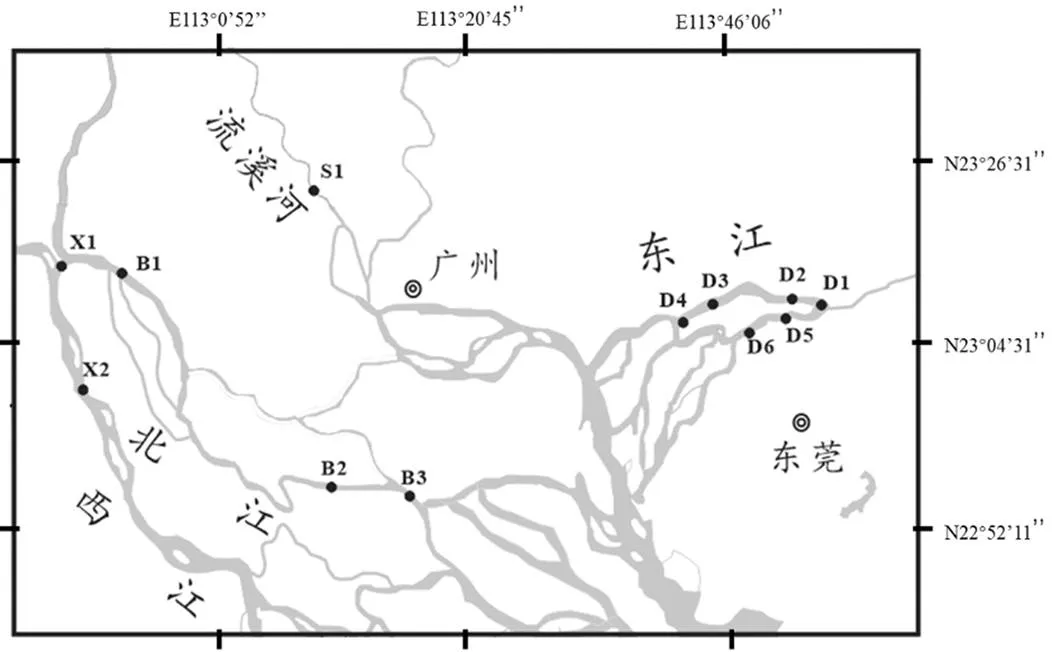
图1 采样点分布
1.3 样品前处理
利用蠕动泵将水样通过玻璃纤维滤膜去除颗粒物后,取1L滤液,加入10ng 的同位素内标,混和均匀;使用全自动固相萃取仪(Auto Trace,Thermo公司)对滤液中的目标化合物进行富集;HLB固相萃取柱预先用6mL乙酸乙酯、6mL乙腈和12mL超纯水活化;仪器设定流速为10mL/min;待样品全部通过固相萃取柱后,使用10mL10%(体积分数)乙腈水溶液进行淋洗、净化,去除干扰基质;柱子经高纯氮气干燥后,用6mL乙酸乙酯:乙腈(1:1,/)和6mL乙酸乙酯进行洗脱.洗脱液合并后经高纯氮气吹至刚干,用甲醇定容至0.5mL,过0.2μm微孔滤膜,待测.
1.4 水样理化参数的测定
采用CDT48M多参数仪(SST,德国)在野外现场测定各采样点的水温(T)、电导率(COND)、溶解氧(DO)、叶绿素a (Chl a)、pH值等环境参数.
1.5 仪器分析
利用高效液相色谱-串联质谱(HPLC-MS/MS, 1260Infinity-6460QQQ, Agilent)对24种目标化合物进行定量分析.色谱柱选择Agilent ZORBAX Eclipse Plus C8柱(100mm×3.0mm,1.8μm).色谱条件:柱温为30℃;进样量为3μL;流动相A为0.1%(/)乙酸,流动相B为乙腈;流速0.3mL/min;液相梯度洗脱程序为0min 28% B;8.0min 28% B;8.1min 40% B;12.0min 40% B;12.1min 60% B;16.0min 70% B;16.5min 100% B; 19.5min 100% B.质谱条件:离子源为ESI±模式,雾化器压力为276kPa(40psi);干燥气温度为300℃,干燥气流速为11L/min;毛细管电压为4000V,采用动态多反应监测(DMRM)模式对目标物的特征离子对扫描[40].使用内标法进行定量,分别定义信噪比S/N=10和S/N=3所对应的浓度作为被测化合的方法定量限和方法检测限(如表1所示).

表1 目标化合物信息及其在水源水中的检出限和定量限(ng/L)
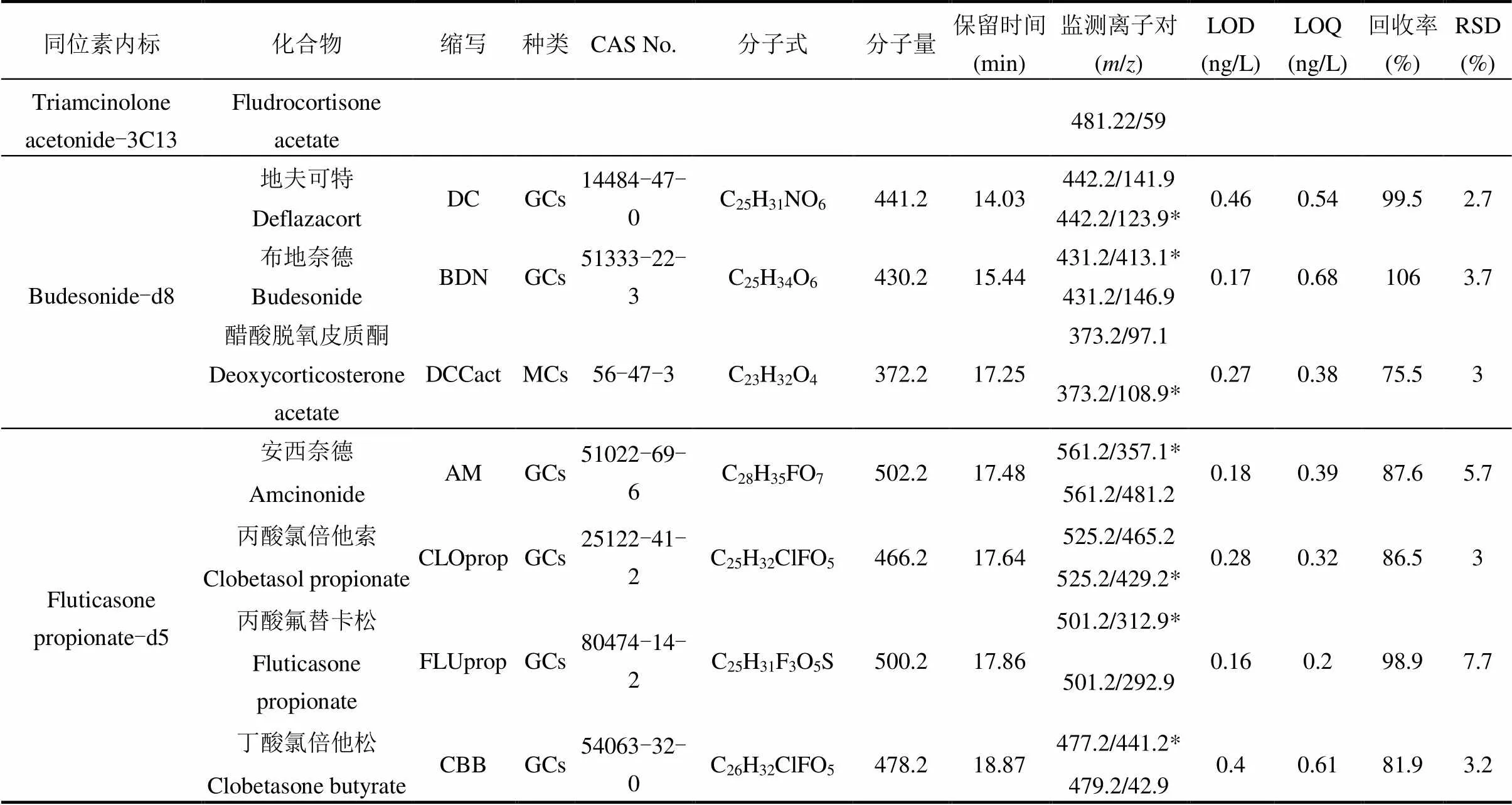
续表1
注:LOD:方法检出限;LOQ:方法定量限;GCs:糖皮质激素;MCs:盐皮质激素;RSD:相对标准偏差;* 定量离子.
1.6 质量控制与质量保证
本研究设置7组标准溶液,质量浓度分别为0.5, 1, 2, 5, 10, 20, 50μg/L,其线性方程的2>0.99.为确保数据的准确性和精密度,每批实验均设有方法空白,加标水样和样品平行,对实验过程进行监控.仪器分析中,每6个样品添加一个溶剂空白和质控标准样,对仪器状态进行监控.实验结果显示,所有空白样品均呈阴性,所有目标化合物的平均回收率在75%~107%,相对标准偏差(RSD)均低于10%,方法检出限范围在0.2~0.68ng/L(如表1所示).
1.7 风险评价方法
根据欧盟技术指导文件(ECTGD)[41]和Hernando等[42]中关于风险评价的方法,本研究采用风险商(RQ)法对水源地的CSs污染进行初步的生态风险评价.该评价标准分为3个风险等级,分别为低风险(RQ<0.1);中等风险(0.1£RQ<1);以及高风险(RQ³1).因受限于当前有限的CSs毒理数据,本文采用地塞米松当量(DEQ)表征CSs对水生生物的风险水平,计算式如下 :
DEQ=REP×MEC (1)
RQ=DEQ/PNEC(DEX)(2)
式中:REP为地塞米松当量因子;MEC为测定的环境暴露浓度,ng/L;PNEC(DEX)为DEX的PNEC值,取值为78.4ng/L[43].选取已有REP值报道的15种CSs进行风险评价,如表2所示.

表2 CSs的REP值汇总
注: EC50为半数效应浓度;REP为地塞米松当量因子.
多种CSs同时存在时,则以混合风险商即危害指数(HI)来表征它们的综合风险水平,如式(3):
HI=ΣRQ(3)
2 结果与讨论
2.1 饮用水源中CSs的组成与浓度水平
西江、北江、流溪河以及东江东莞段水源地中CSs的检出浓度如表3所示.3种MCs和21种GCs在水样中均有检出,检出率在8%(COR)~75%(DC),其中GCs的浓度范围为<0.38(PNL)~4.7ng/L (BDN), MCs的平均浓度在<0.2(FLCact)~2.24ng/L (ADS)之间,表明CSs广泛存在于珠三角水源水中.水样中CSs的总浓度(ΣCSs)在0.29~8.7ng/L之间,平均值和中值分别为2.6和1.6ng/L.
有7种GCs和1种MCs在冬夏两季均被检出,平均浓度在0.23ng/L(DC)~3.8ng/L(BDN)之间. ΣCSs的浓度水平和组成存在一定季节性差异,夏季的污染水平普遍高于冬季.冬季水样中有1~8种的CSs被检出,ΣCSs浓度平均值和中位值(范围)分别为0.57和0.34ng/L(未检出(ND)~2.2ng/L),其中CLOprop和CRL的检出率较高,均达到50%;夏季各水源地中均有1~7种CSs被检出,ΣCSs浓度平均值和中位值(范围)分别为0.90和0.37ng/L (ND~4.7ng/L),其中DC和BDN的检出率分别高达75%和50%.此外,冬夏两季的目标物的组成也存在显著差异.冬季水源地污染以CLOprop、BDN和ADS为主,分别占当季CSs总量的29%、13%和11%,而夏季的污染则主要来自BDN,其贡献高达56%.

表3 珠三角水源水中CSs的浓度水平(ng/L)
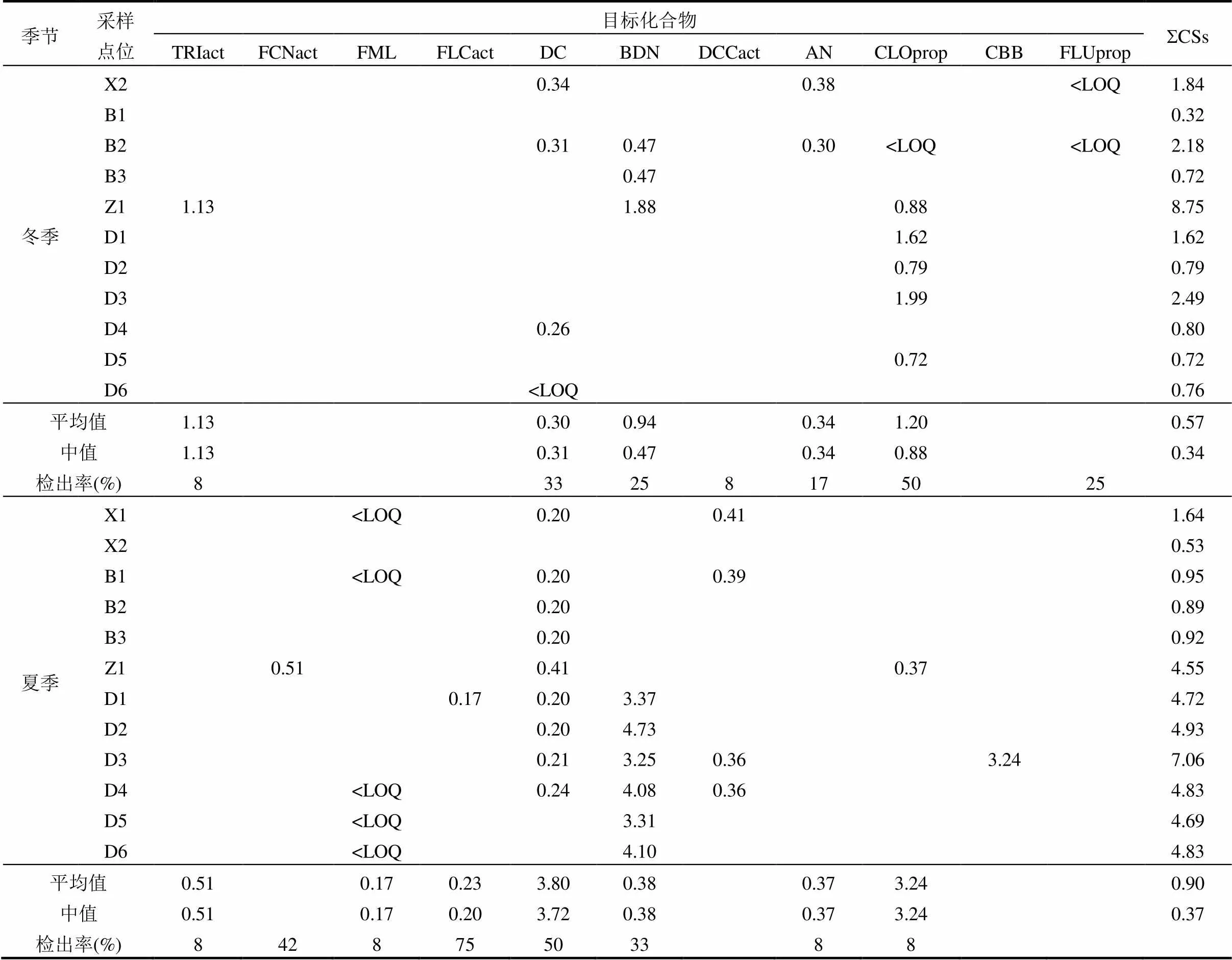
续表3
注: LOQ为定量限.
2.2 水源地CSs的时空分布
如图2所示,西江和北江冬夏两季ΣCSs浓度平均值均在1ng/L左右,无显著差异.流溪河石门的水样中测得较高浓度的CSs,可能与该点位于流溪河下游,距离广州市区较近,受居民生活污水排放影响有关.冬季石门水源水中ΣCSs浓度高达8.8ng/L,约高出夏季1倍(4.5ng/L),这主要因为夏季(丰水季)降雨量(占全年总量的85%以上)[44]、径流量(约为枯水季的10倍)[45]大,对污染物的稀释作用较为明显.东江水源地的情况则不相同,其冬季ΣCSs浓度平均值为1.2ng/L,明显低于夏季的平均水平(5.2ng/L).该季节性差异可能与周边的工农业生产生活的季节性排放有关,具体的原因有待进一步的调查.
空间分布上,4条河流水源地CSs的总体污染水平(ΣCSs浓度平均值)为:东江东莞段(1.2ng/L)>流溪河石门(0.95ng/L)>北江(0.55ng/L)>西江(0.40ng/L).东江东莞段水源地中, BDN和CLOprop为主要污染物,分别占改水源地总污染物浓度水平的60%和13%.而在流溪河中,检出的CSs类较多,污染以ADS、BC、FN、BDN以及CLOprop为主,它们的浓度之和占珠江水源总污染物浓度水平的58%.值得注意的是,人工合成GCs中BDN和CLOprop在东江东莞段和流溪河石门水源地均是主要的污染物,这可能与它们的广泛使用有关.作为常见、常用的2种CSs类药物,它们广泛应用于皮肤病和鼻炎的治疗.加之东莞、广州两地人口稠密、药物使用量较大,这些化合物可随生活污水大量地排入附近流域,进而影响水源地的水质.另外,冬季珠江三角洲河流水源地中CSs的分布总体呈现下游高于上游的特征.例如,北江ΣCSs从上游的0.32ng/L(B1)到下游的2.18 (B2)和0.72ng/L(B3),西江ΣCSs从上游的0.29ng/L(X1)到下游的1.84ng/L(X2),东江东莞段ΣCSs从上游的0.79ng/L(D2)到下游的2.49ng/L(D3).这可能因为西江、北江和东江上游人口稀疏,人类活动较少,而下游接近城市及工业园区,因此有相当数量的污染物随废水进入到环境中,并在下游聚集.而在夏季,雨、水丰沛,受稀释作用影响,上述流域中的CSs并无明显的空间分布特征.
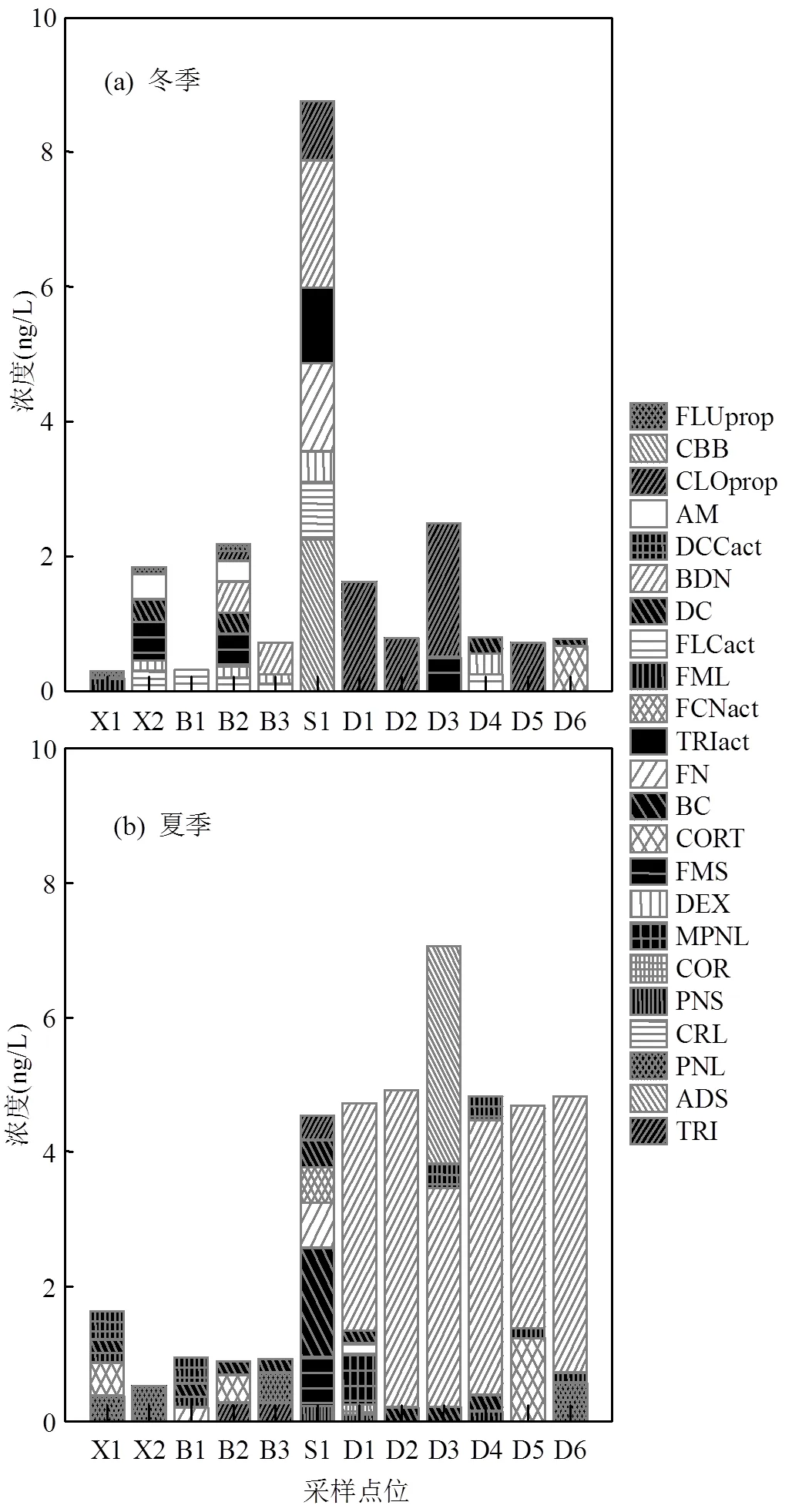
图2 珠江三角洲河流水源地中CSs的时空分布
2.3 CSs与环境参数的相关性
对所有检出的CSs进行了去趋势对应分析,发现排序中第一轴的长度为1.4(<3),因此可以采用冗余分析(RDA)来评估CSs浓度与环境参数之间的相关性[46].结果如图3所示.前两主轴的特征值分别为85.7%和10.8%,共解释了总变量关系的96.5%.图中箭头的长度反映了两者之间的关系强度而箭头间交点的夹角则表示相关程度.相关性分析发现, CSs的浓度与DO、水温均呈负相关关系,这一结果与之前一些典型EEDCs以及PPCPs的研究结果相似[34,47-48].这可能因为在水温较高、溶解氧充足的条件下,水中微生物及浮游生物的活性较大,它们对水相中CSs的降解、吸附作用也随之增强,以致其浓度降低[49-50].部分CSs与COND呈负相关关系的这一发现与之前EEs的研究结果类似[51].由于盐析效应的影响, CSs更易于与颗粒物等非水相介质结合,以致CSs的水溶性降低.pH值与CSs浓度呈负相关关系,可能与CSs的酸离解常数(pKa)有关.在不同的pH值条件下,颗粒物对CSs吸附作用会受到去质子化程度的影响[52].本研究水样的pH值在6.4~8.0之间,高于大部分CSs的pKa值(0~13.81)[53],它们大多以非离子形态存在,易于被颗粒物吸附.环境中pH值越高越不利于大部分CSs离解成离子状态赋存于水相.

图3 水源水中CSs与水环境因子的冗余分析
2.4 风险评价
就化合物而言,所有水样中TRI、ADS、PNL、CRL、PNS、COR、MPNL、DEX、FMS、FN、TRIact、FCNact、FML、FLCact、AM、FLUprop的RQ值均低于0.1,表明它们的风险水平较低;BDN(<0.1~ 0.42)和CLOprop(<0.1~0.94)的RQ值则相对较高,处于中低风险水平.
水源地的总RQ(ΣRQs)即HI的时空分布如图4所示.从季节上看,冬季CSs的HI值范围(中值):< 0.1~0.97(0.30)处于中低风险水平,其中CLOprop是主要贡献者,其RQ范围在<0.1~0.94之间.夏季水源地HI范围(中值)在<0.1~0.42之间(0.29),主要贡献来自BDN(RQ:0.30~0.42).冬季西江、北江、流溪河以及东江东莞段的HI范围(中值)分别为<0.1~0.15 (0.12),<0.1~0.25(0.10),0.69,<0.1~0.97(0.49),表明各个流域水源地均处于中低风险水平,主要贡献来自FLUprop、CLOprop、BDN等人工合成的CSs.夏季西江和北江各取样点的HI值均<0.1,处于低风险水平;流溪河石门和东江东莞段水源水的HI值分别为0.3、0.30~0.42(0.34),处于中等风险水平,风险的主要来源与冬季情况相似.

图4 珠江三角洲河流水源地中CSs的总风险商(危害指数)
空间上,西江、北江、流溪河石门和东江东莞段水源地两季HI平均值范围分别为<0.1~0.15,<0.1~ 0.25,0.63,0.19~0.65,总体处于中低风险水平.其中,西江和北江水源中CSs风险的主要贡献来自FLUprop,贡献率分别为74%和29%,而流溪河和东江东莞段水源地的风险则主要来自CLOprop和BDN,贡献率分别为47%、26%(流溪河石门)以及53%、44%(东江东莞段).
综上所述,珠江三角洲河流水源地在冬季的潜在生态风险大于夏季,西江、北江处于低风险水平,而流溪河和东江东莞段处于中等风险.
3 结论
3.1 珠江三角洲河流饮用水源中,ΣCSs浓度(平均值/中值)在0.29~8.7ng/L(/1.6ng/L)之间,污染主要以CLOprop、BDN、ADS等人工合成GCs为主.东江东莞段和流溪河水源水中CSs浓度水平总体高于西江和北江.不同流域水源地的CSs组成与浓度存在一定的季节性差异
3.2 RDA分析结果显示,水源水中大部分CSs与T、COND、pH值以及DO呈负相关关系,表明上述环境因子在控制水源水中CSs的发生和分布方面发挥着重要作用.
3.3 初步的风险评价发现,珠三角河流水源地CSs的HI(平均值/中值)在<0.1~0.65(0.25/0.29ng/L)之间,其中西江、北江水源处于低风险水平,而流溪河和东江东莞段水源则处于中等风险水平.结果表明,珠三角部分饮用水源地CSs的污染可能已对水生态及饮用水安全形成威胁,其环境效应不容忽视.
[1] 李 杰,司纪亮.环境内分泌干扰物质简介[J]. 环境与健康杂志, 2002,19(1):83-84. Li J, Si J L. Introduction of environmental endocrine disruptors [J]. Journal of Environment and Health, 2002,19(1):83-84.
[2] 龚 剑,黄 文,杨 娟,等.珠江河流胶体中的典型内分泌干扰物[J]. 中国环境科学, 2015,35(2):617-623. Gong J, Huang W, Yang J, et al. Occurrence of colloid-bound endocrine-disrupting chemicals in Pearl River, China [J]. China Environment Science, 2015,35(2):617-623.
[3] 陈玫宏,郭 敏,刘 丹,等.典型内分泌干扰物在太湖及其支流水体和沉积物中的污染特征[J]. 中国环境科学, 2017,(11):325-334. Chen M H, Guo M, Liu D, et al. Occurrence and distribution of typical endocrine disruptors in surface water and sediments from Taihu Lake and its tributaries [J]. China Environment Science, 2017,(11):325-334.
[4] Ying G G, Kookana R S, Ru Y J. Occurrence and fate of hormone steroids in the environment. [J]. Environment International, 2003,28(6): 545-551.
[5] Hotchkiss A K, Rider C V, Blystone C R, et al. Fifteen Years after "Wingspread"--Environmental Endocrine Disrupters and Human and Wildlife Health: Where We are Today and Where We Need to Go [J]. Toxicological Sciences, 2008,105(2):235-259.
[6] 赵砚彬,胡建英.环境孕激素和糖皮质激素的生态毒理效应:进展与展望[J]. 生态毒理学报, 2016,11(2):6-17. Zhao J B, Hu J Y. Ecotoxicology of environmental progestogens and glucocorticoids: A short review [J]. Asian Journal of Ecotoxicology, 2016,11(2):6-17.
[7] 王 鸿,潘 秋,王静花,等.环境皮质激素的危害与环境行为[J]. 浙江工业大学学报, 2016,44(2):159-163. Wang H, Pang Q, Wang J H, et al. Impact and behaviors of corticosteroids in environment [J]. Journal of Zhejiang University of Technology, 2016,44(2):159-163.
[8] Vijayan M M, Raptis S, Sathiyaa R. Cortisol treatment affects glucocorticoid receptor and glucocorticoid-responsive genes in the liver of rainbow trout [J]. General and Comparative Endocrinology, 2003,132(2):256-263.
[9] Nussey S S, Whitehead S A. Endocrinology: An Integrated Approach [M]. 2001.
[10] Kugathas S, Williams R J, Sumpter J P. Prediction of environmental concentrations of glucocorticoids: The River Thames, UK, as an example [J]. Environment International, 2012,40(1):15-23.
[11] Jia A, Wu S, Daniels K D, et al. Balancing the budget: Accounting for glucocorticoid bioactivity and fate during water treatment [J]. Environmental Science & Technology, 2016,50(6):2870-2880.
[12] Fan Z, Wu S, Chang H, et al. Behaviors of glucocorticoids, androgens and progestogens in a municipal sewage treatment plant: Comparison to estrogens [J]. Environmental Science & Technology, 2011,45(7): 2725-2733.
[13] Chang H, Hu J, Shao B. Occurrence of Natural and Synthetic Glucocorticoids in Sewage Treatment Plants and Receiving River Waters [J]. Environmental Science & Technology, 2007,41(10):3462- 3468.
[14] Chang H, Wan Y, Hu J. Determination and source apportionment of five classes of steroid hormones in urban rivers [J]. Environmental Science & Technology, 2009,43(20):7691-7698.
[15] Macikova P, Groh K J, Ammann A A, et al. Endocrine disrupting compounds affecting corticosteroid signaling pathways in czech and swiss waters: potential impact on fish [J]. Environmental Science & Technology, 2014,48(21):12902.
[16] Øverli Ø, Kotzian S, Winberg S. Effects of cortisol on aggression and locomotor activity in rainbow trout [J]. Hormones & Behavior, 2002, 42(1):53-61.
[17] 安立会,雷 坤,刘 颖,等.辽东湾野生四角蛤蜊性畸变调查[J]. 中国环境科学, 2014,34(1):259-265. An L H, Lei K, Liu Y, et al. Investigation the intersex of wild Mactra veneriformis from Liaodong Bay [J]. China Environmental Science, 2014,34(1):259-265.
[18] Kugathas S, Sumpter J P. Synthetic glucocorticoids in the environment: First results on their potential impacts on fish [J]. Environmental Science & Technology, 2011,45(6):2377-2383.
[19] 侯彦峰,张照斌,胡建英.皮质醇影响青鳉鳃内钠钾ATP酶基因表达的研究[J]. 生态毒理学报, 2009,4(2):212-217. Hou Y F, Zhang Z B, Hu J Y. Effects of cortisol on Na+-K+-ATPase Gene Expression in Gill of Medaka (Oryzias latipes) [J]. Asian Journal of Ecotoxicology, 2009,4(2):212-217.
[20] Zhao Y, Zhang K, Fent K. Corticosteroid fludrocortisone acetate targets multiple end points in Zebrafish () at low concentrations [J]. Environmental Science & Technology, 2016,50: 10245-10524.
[21] Liu S, Chen H, Xu X R, et al. Steroids in marine aquaculture farms surrounding Hailing Island, South China: Occurrence, bioconcentration, and human dietary exposure [J]. Science of The Total Environment, 2015,502:400-407.
[22] Weizel A, Schluesener M P, Dierkes G, et al. Occurrence of Glucocorticoids, Mineralocorticoids and Progestogens in Various Treated Wastewater, Rivers and Streams [J]. Environmental Science & Technology, 2018,52:5296-5307.
[23] Adeel M, Song X, Francis D, et al. Environmental impact of estrogens on human, animal and plant life: A critical review [J]. Environment International, 2016,99:107-119.
[24] 万军明,梁润秋,区卫华.水源水中有机污染物的研究[J]. 环境与开发, 1998,13(1):29-30. Wang J M, Liang R Q, Ou W H. Study on organic pollutant of water source [J]. Environment and Exploitation, 1998,13(1):29-30.
[25] 王子钊,张锡辉,王凌云.深圳河典型内分泌干扰物分布和季节变化规律研究[J]. 环境污染与防治, 2013,35(9):9-13+18. Wang Z Z, Zhang X H, Wang L Y. Distribution and seasonal variation of typical endocrine disrupting chemicals in Shenzhen River [J]. Environmental Pollution and Control, 2013,35(9):9-13+18.
[26] 龚 剑,冉 勇,黄 文,等.内分泌干扰物在珠三角河水多相中的分配及风险[J]. 生态毒理学报, 2016,11(2):518-523. Gong J, Ran Y, Huang W, et al. Partitioning and risk of endocrine- disrupting chemicals in multiphases of the rivers from the Pearl River Delta, China [J]. Asian Journal of Ecotoxicology, 2016,11(2):518- 523.
[27] Liu Y H, Zhang S H. Occurrence, distribution and risk assessment of suspected endocrine-disrupting chemicals in surface water and suspended particulate matter of Yangtze River (Nanjing section). Ecotoxicology and Environmental Safety1, 2017,35:90–97.
[28] Gong J, Huang Y, Huang W, et al. Multiphase partitioning and risk assessment of endocrine-disrupting chemicals in the Pearl River, China [J]. Environmental Toxicology and Chemistry, 2016,35:2474- 2482.
[29] Gong J, Ran Y, Chen D, et al. Association of endocrine-disrupting chemicals with total organic carbon in riverine water and suspended particulate matter from the Pearl River, China [J]. Environmental Toxicology and Chemistry, 2012,31:2456-2464.
[30] Gong J, Ran Y, Chen D, et al. Occurrence and environmental risk of endocrine-disrupting chemicals in surface waters of the Pearl River, South China [J]. Environmental Monitoring & Assessment, 2009, 156(1-4):199-210.
[31] Gong J, Ran Y, Zhang D, et al. Vertical profiles and distributions of aqueous endocrine-disrupting chemicals in different matrices from the Pearl River Delta and the influence of environmental factors [J]. Environmental. Pollution, 2019,246:328-335.
[32] Liu S, Chen H, Zhou G J, et al. Occurrence, source analysis and risk assessment of androgens, glucocorticoids and progestagens in the Hailing Bay region, South China Sea [J]. Science of The Total Environment, 2015,536:99-107.
[33] Yang L, Cheng Q, Lin L, et al. Partitions and vertical profiles of 9endocrine disrupting chemicals in an estuarine environment: Effect of tide, particle size and salinity [J]. Environmental Pollution, 2016,211: 58-66.
[34] Zhao J L, Ying G G, Chen F, et al. Estrogenic activity profiles and risks in surface waters and sediments of the Pearl River system in South China assessed by chemical analysis and in vitro bioassay [J]. Journal of Environmental Monitoring, 2011,13(4):813-821.
[35] 王若师,张 娴,许秋瑾,等.东江流域典型乡镇饮用水源地有机污染物健康风险评价[J]. 环境科学学报, 2012,32(11):2874-2883. Wang R S, Zhang X, Xiu Q J, et al. Health risk assessment of organic pollutants in typical township drinking water sources of Dongjiang River Basin [J]. Acta Scientiae Circumstantiae, 2012,32(11):2874- 2883.
[36] 樊静静,王 赛,唐金鹏,等.广州市流溪河水体中6种内分泌干扰素时空分布特征与环境风险[J]. 环境科学, 2018,(3):1053-1064. Fan J J, Wang S, Tang J P, et al. Spatio-temporal patterns and environmental risk of endocrine disrupting chemicals in the Liuxi River [J]. Environmental Science, 2018,(3):1053-1064.
[37] 程 晨,陈振楼,毕春娟,等.中国地表饮用水水源地有机类内分泌干扰物污染现况分析[J]. 环境污染与防治, 2007,29(6):446-450. Cheng C, Chen Z L, Bi C J, et al. The current status of organic endocrine disrupting chemicals in the surface drinking water sources of China [J]. Environmental Pollution & Control, 2007,29(6):446-450.
[38] Guo L, Li Z Y, Gao P, et al. Ecological risk assessment of bisphenol A in surface waters of China based on both traditional and reproductive endpoints [J]. Chemosphere, 2015,139:133-137.
[39] Gao P, Li Z Y, Gibson M, et al. Ecological risk assessment of nonylphenol in coastal waters of China based on species sensitivity distribution model [J]. Chemosphere, 2014,104:113-119.
[40] 龚 剑,林粲源,熊小萍,等.超高效液相色谱⁃电喷雾串联质谱法同时测定地表水中28种皮质激素[J]. 色谱, 2018,36(11):1158-1166. Gong J, Lin C Y, Xiong X P, et al. Simultaneous determination of corticosteroids in surface water by high performance liquid chromatography-electrospray tandem mass spectrometry [J]. Chinese Journal of Chromatography, 2018,36(11):1158-1166.
[41] EC (European Commission), 2003. European Commission Technical Guidance Document in Support of Commission Directive 93/67/EEC on Risk Assessment for New Notified Substances and Commission Regulation No 1488/94on Risk Assessment for existing substances, Part II. In: Commission E (Ed.). Luxembourg: Office for official publications of the European Communities.
[42] Hernando M D, Mezcua M, Fernández-Alba A R, et al. Environmental risk assessment of pharmaceutical residues in wastewater effluents, surface waters and sediments [J]. Talanta, 2006, 69(2):334-342.
[43] Lorenz C, Opitz R, Lutz I, et al. Corticosteroids disrupt amphibian metamorphosis by complex modes of action including increased prolactin expression. [J]. Comp Biochem Physiol C Toxicol Pharmacol, 2009,150(2):314-321.
[44] Guangzhou Water Bureau. http://www.gzwater.gov.cn/portal/site/site/ portal/gzswj/index.portal [Z].
[45] Bureau of Hydrology of Guangzhou. http://swj.gd.gov.cn/index/ index.html [Z].
[46] Liu W R, Zhao J L, Liu Y S, et al. Biocides in the Yangtze River of China: Spatiotemporal distribution, mass load and risk assessment [J]. Environmental Pollution, 2015,200:53-63.
[47] You L, Nguyen V T, Pal A, et al. Investigation of pharmaceuticals, personal care products and endocrine disrupting chemicals in a tropical urban catchment and the influence of environmental factors [J]. Science of the Total Environment, 2015,536:955-963.
[48] Ferguson P J, Bernot M J, Doll J C, et al. Detection of pharmaceuticals and personal care products (PPCPs) in near-shore habitats of southern Lake Michigan [J]. Science of the Total Environment, 2013,458- 460(3):187-196.
[49] Koumaki E, Mamais D, Noutsopoulos C, et al. Degradation of emerging contaminants from water under natural sunlight: The effect of season, pH, humic acids and nitrate and identification of photodegradation by-products [J]. Chemosphere, 2015,138:675-681.
[50] Fan Z, Wu S, Chang H, et al. Behaviors of Glucocorticoids, Androgens and Progestogens in a Municipal Sewage Treatment Plant: Comparison to Estrogens [J]. Environmental Science & Technology, 2011,45(7):2725-2733.
[51] Yang L, Cheng Q, Lin L, et al. Partitions and vertical profiles of 9endocrine disrupting chemicals in an estuarine environment: Effect of tide, particle size and salinity [J]. Environmental Pollution, 2016,211: 58-66.
[52] You L, Nguyen V T, Pal A, et al. Investigation of pharmaceuticals, personal care products and endocrine disrupting chemicals in a tropical urban catchment and the influence of environmental factors [J]. Science of the Total Environment, 2015,536:955-963.
[53] Online Drug Information System. http://druginfosys.com/.
Occurrence and risks of typical corticosteroids in drinking water sources of the rivers from the Pearl River Delta.
LIN Can-yuan1,2, GONG Jian1,2*, XIONG Xiao-ping1,2, ZHOU Yong-shun1,2, WU Cui-qin1,2
(1.Guangdong Provincial Key Laboratory of Radionuclides Pollution Control and Resources, School of Environmental Science and Engineering, Guangzhou University, Guangzhou 510006, China;2.Key Laboratory for Water Quality and Conservation of the Pearl River Delta, Ministry of Education, Guangzhou University, Guangzhou 510006, China)., 2019,39(11):4752~4761
The occurrence and eco-risks of typical corticosteroids (CSs) including 21 glucocorticoids and 3 mineralocorticoids were studied in the drinking water sources of the rivers from the Pearl River Delta. The solid phase extraction and liquid chromatography-mass spectrometry were employed. The 24 target compounds were all detected in the source water samples. Their detection frequencies ranged from 8% (cortisone) to 75% (deflazacort), and the total concentrations (∑CSs) were in a range (mean/median) of 0.29~8.7ng/L (2.6ng/L/1.6ng/L). Budesonide, clobetasol propionate and aldosterone were the major pollutants. The concentrations of CSs in the source water from the Dongjiang River and lower reach of the Liuxi River were generally higher than those of the Xijiang River and Beijiang River. Besides the CS compositions and concentrations varied seasonally from river to river. Redundancy analysis showed that most of CSs in the source water were negatively correlated with water temperature, conductivity, pH, and dissolved oxygen, suggesting that the occurrence and distribution of CSs in the source water can be influenced by these environmental factors. Moreover, the hazard index (HI) of CSs in the water sources of the Pearl River Delta ranged from <0.1to 0.65 (mean/median: 0.25/0.29), indicating that low and medium risks were present in these waters.
corticosteroids;drinking water source;endocrine disrupting chemicals;Pearl River Delta
X522
A
1000-6923(2019)11-4752-10
林粲源(1994-),男,广东广州人,广州大学硕士研究生,主要从事内分泌干扰物的水陆环境行为、风险研究.发表论文3篇.
2019-04-18
国家自然科学基金资助面上项目(41673110);广州市科技计划项目(201607010217)
* 责任作者, 副研究员, gong_jian@mails.ucas.ac.cn
